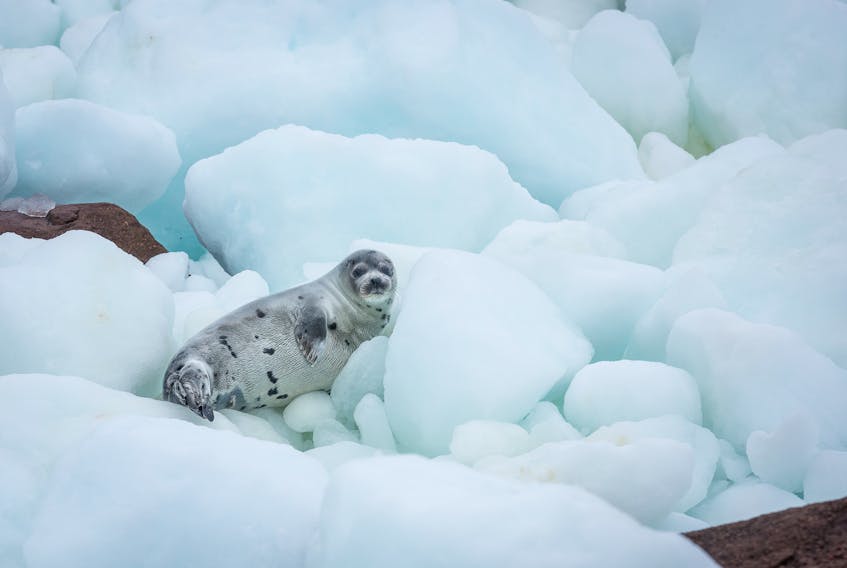TWILLINGATE, N.L. — The role harp seals play in the province’s rebounding cod fishery remains an area of debate and contention.
The recent report on the harmful impact of grey seals on cod in the Gulf of St. Lawrence and a new cull on sea lions to protect salmon stocks in the United States is sparking even more talk around the effect harp seals are having on cod in the North Atlantic.
However, Dr. Garry Stenson says in his three decades studying seal populations there is little evidence to suggest that harp seals are playing a significant role in the health of northern cod stocks.
“We could not find any indication that seal predation on cod was in fact driving the dynamics of cod stocks,” Stenson said in an interview with The Central Voice. “Since the closure of the major offshore fishery, it’s largely capelin abundance that has the major impact. And the capelin numbers are largely being driven by changes in the environment – the timing of ice retreats has a huge influence on the abundance of capelin.”
Stenson is a research scientist and head of the Department of Fisheries and Oceans (DFO) Marine Mammal Section. He says through the DFO’s research and modelling exercises that test various components and how they affect cod populations, the conclusion was that cod stocks are affected by a bottom-up rather than top-down model.
Bottom-up meaning that capelin abundance and environmental conditions determine the cod’s biomass, rather than a top-down model of predation from species like seals.
“We could not find any indication that seal predation on cod was in fact driving the dynamics of cod stocks.” — Dr. Garry Stenson
With seals spending much of their year in the Arctic, Stenson says when looking at the bigger picture, cod is not a major part of the seal’s diet.
“We have to look at the full range of what they eat and how much time they spend in each area,” he said. “Harp seals spend half their year in the Arctic, and up north they feed primarily on zooplankton and Arctic cod. In Bonavista Bay the seals eat a lot of northern cod, but they don’t typically show up in large numbers in those places.”
In a 2014 academic paper “The role of harp seals, fisheries and food availability in driving the dynamics of northern cod”, scientists gauged how each of these three factors contributed to the recovery and dynamics of the northern cod stocks. According to Stenson, while cod consumption by seals is estimated to be in the hundreds of thousands of tons annually, their testing of this model showed capelin availability as the major player in affecting cod stocks.

Grey seals in the southern gulf
The science around grey seals in the southern Gulf of St. Lawrence is painting a different picture.
According to a new report published in the Canadian Journal of Fisheries and Aquatic Sciences, cod in the southern Gulf are at a high natural mortality rate of 50 per cent, and 45 per cent of that high mortality is due to predation from grey seals.
“Mortality in these adult codfish has gone to extremely high levels,” said Doug Swain, a co-author of the report and scientist with Fisheries and Oceans Canada. “The losses due to grey seals is certainly the dominant proportion of its natural mortality.”
Based on the data of their report, cod biomass in 2010 was about 36, 374 tonnes, and grey seals consumption of adult cod was an estimated 16,315 tonnes.
The report states that the population of grey seals in this area has been around 400,000 since 2014. Swain says a normal natural mortality for these cod would be around 18 per cent annually.
Although his work does not specify in the study of harp seals, Swain says there are several factors that show why science is not finding a similar picture with cod and harp seals in the North Atlantic.
“Grey seals are considerably larger than harp seals, and have much bigger diets,” he said. “Grey seals also eat in this area year-round, and about half of these seals’ diet is cod.”
“Mortality in these adult codfish has gone to extremely high levels. The losses due to grey seals is certainly the dominant proportion of its natural mortality.” — Doug Swain
Stenson agrees that the role of predation highly differs in the southern Gulf of St. Lawrence. From the smaller biomass of Gulf cod to the grey seals year-round feed, Stenson says these factors show why grey seals pose a danger to the future of these cod stocks, but harp seals do not have the same role off the shores of Newfoundland and Labrador. While harp seals do feed sometimes in the Gulf of St. Lawrence, it is not as extensive as grey seals.
Population and recent sightings
When the abundance of harp seals fell in the 1950s and ‘60s, new quotas were introduced in 1971 with the intention of letting the population increase.
According to DFO documents, the population had declined to 1.1 million in 1971 but was up as high as 7.8 million by 2008.
Between 2002 and 2006, the commercial harvest for Atlantic harp seals removed around 300,000 seals per year. Since 2009, due to weaker markets and difficult ice conditions, the number of seals removed has dropped to an estimated 100,000 annually.
Now a growing area of contention for harvesters is that, without a larger hunt, harp seals are going to become more plentiful, and their consumption of cod will only increase alongside their population.
In January, reports of seals around the Conche and Roddickton-Bide Arm areas of the Northern Peninsula began to hit the news, with some seals spotted in groups of as many as 35. In the Burin Peninsula, a seal managed to make its way to the Burin Peninsula Health Centre and had to be removed from the area by RCMP and DFO officers.

Stenson’s work largely focuses on the dimensions of seal populations, and he says climate change and its effects on ice are having a negative impact on harp seals.
“Harp seals are the most abundant marine mammal in the north Atlantic, and though there’s variability we’re seeing a general decline in recent years with pup production. With climate change we’re seeing poorer and poorer ice conditions. These seals give birth on the ice and when the ice is bad many of the pups get dumped into the water and drown.” — Dr. Stenson
In “Conservation of northwest Atlantic harp seals: past success, future uncertainty”, a 2015 academic paper Stenson co-authored, a population model that incorporated reproductive rates, removals and ice-related mortality was used to the test the impacts of changing environments on seal stocks. With an expected decline in the coming years of season pack ice in Atlantic Canada, the paper states there is uncertainty over the future of the harp seal’s population.
“Harp seals are the most abundant marine mammal in the north Atlantic, and though there’s variability we’re seeing a general decline in recent years with pup production,” Stenson said. “With climate change we’re seeing poorer and poorer ice conditions. These seals give birth on the ice and when the ice is bad many of the pups get dumped into the water and drown.”
The last major assessment of the harp seal population was done in 2014, showing a population of about seven million. Stenson says a new assessment is underway and the results are expected to be brought to the public at the end of 2019.
See Part II here.
Want in on the debate?
Write us a letter to the editor and email it to [email protected]. Be sure to include a name, address and daytime telephone number where the author can be contacted. Letters should be no more than 300 words.
RELATED









